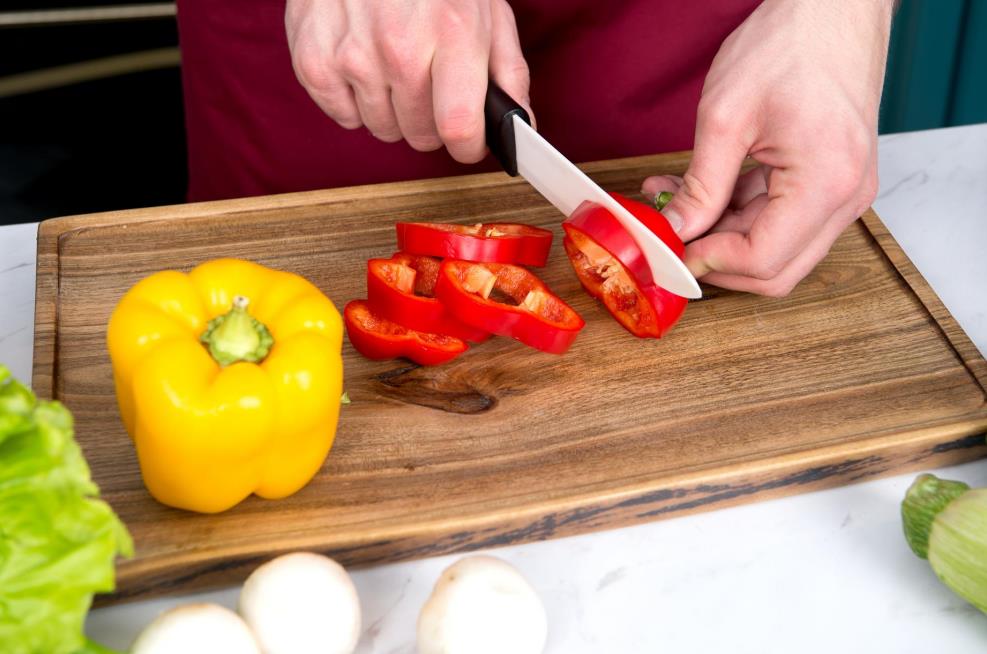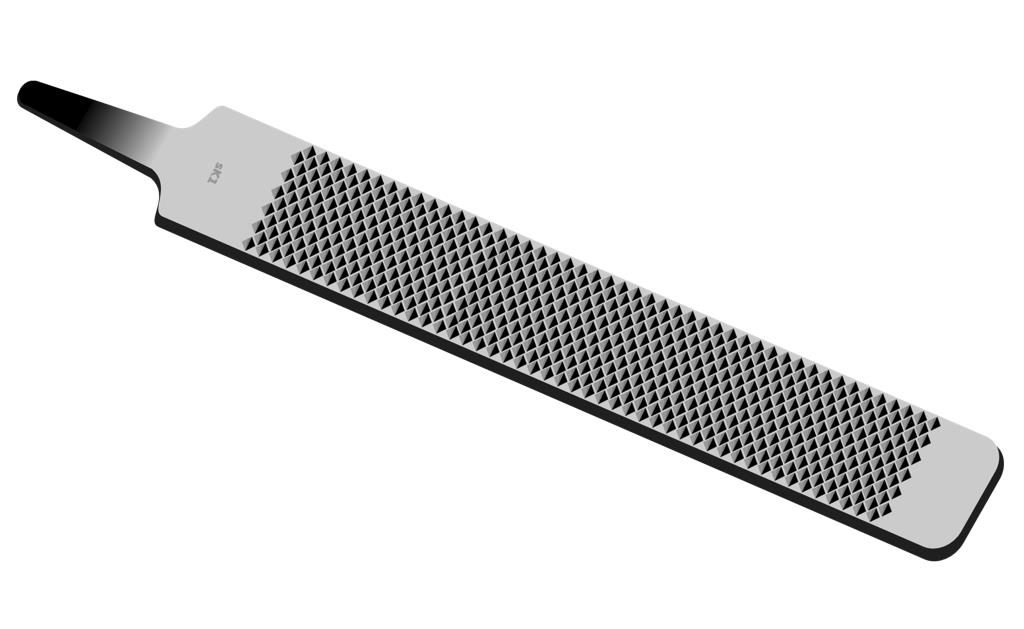Ceramic kitchen knives are pretty different than others made from steel. One of the main differences is the way to sharpen the blade. Ceramic blades have one of the longest edge retention, if not the longest, but this is a very tricky subject.
This article will go through everything you need to know about sharpening a ceramic kitchen knife and whether or not you can do it at home.
Table of contents
Do ceramic knives get dull?
The claim that ceramic knives never dull is far from reality. A ceramic knife will hold an edge significantly longer than its steel or even high carbon steel counterparts but dull eventually.
The tiny bitty microchips on the ceramic blade’s edge will cause it not to cut as efficiently as opposed to rolled-over edges in steel knives. Like sharpening any other blade, you will need to remove material from the edge to create a new, sharper one.
Know when to sharpen a ceramic knife
Because sharpening a ceramic knife takes significantly more effort – more on that in a bit – you shouldn’t take your chances unless the blade really needs it.
The blade not cutting as good as it first came out of the box is one thing; struggling to dice tomatoes is another. When the knife isn’t up to your expectations or preparing ingredients becomes a struggle, that’s when you know it needs sharpening. This applies to not just ceramic blades but any other.
An easy way to tell if your ceramic knife is dull is by gently running your fingertips over the blade’s edge. If it feels sharp, it’s probably better to wait a little longer, but be your own judge and decide when to do it yourself.
How to sharpen a ceramic kitchen knife at home

There are different tools you can utilize to sharpen a ceramic blade at home. How you will use them is somewhat the same. Nonetheless, paying attention to the small details that differ in each method is a crucial step to prevent damaging the blade.
Here is how to use different tools to sharpen your ceramic kitchen knife.
Sharpen with a diamond sharpening stone
If you sharpened a kitchen knife using a traditional whetstone before, also known as water stones, using a diamond sharpening stone will be the best choice to sharpen a ceramic knife.
Why diamond?
The traditional whetstones mostly contain aluminum oxide and silicon carbide. These materials are extremely abrasive for steel but don’t perform the same with ceramic. Because it is about three times harder than steel, ceramic needs something much harder.
Diamond is one of the few accessible materials harder than ceramic and other materials that are just as hard. That’s why diamond is widely available. However, diamond isn’t only used for ceramic knives. It makes up a small portion of its uses and is usually put use in grinding wheels, drill bits, and saw blades.
There isn’t a significant difference between using a diamond sharpening stone to sharpen a ceramic knife compared to a traditional whetstone to sharpen a steel knife. The exception is how you use it. Sharpening a ceramic blade can damage the blade and create microchips if you do it the same way as a steel knife.
Follow these steps to sharpen a ceramic knife.
Steps to sharpen a ceramic knife using a diamond whetstone
- Position the sharpening stone vertically on a stable surface.
- Flip the lower grit side of the diamond sharpening stone if it has two surfaces in one and lubricate using water.
- Some diamond sharpening stones don’t need lubricant, whether water or oil. Follow the specific instructions of the diamond sharpening stone you’re using.
- Hold the knife at the correct sharpening angle and stroke the blade from the heel to the tip. Keep each back and forth movement on the sharpening stone consistent.
- After about five minutes, follow up with the other side of the blade.
- Once the blade is sharp enough, polish the edge using the higher grit stone. The lower coarseness in higher grit stones remove microscopic marks, giving you a clean, finished edge – much like removing the burr from steel blades.
Tips
- Ceramic knives don’t form a burr on the other side as it isn’t a flexible material. Because of this, it’s harder to tell when to flip the knife and sharpen the other side. It’s crucial to sharpen both sides evenly so that you don’t end up with an asymmetrical edge.
- Maintain consistent movements from the heel to the tip. This isn’t only important to have the right V-shape edge but also affects how sharp the knife becomes.
- Keep the pressure on the blade gentle, especially when holding the knife laterally. Ceramic is an extremely brittle material, and exerting too much stress can have the same effect as dropping it to the floor. If you’re not careful enough, the next thing you know, the blade is in pieces.
Sharpening with a diamond file

A diamond file is also a practical way to sharpen a ceramic knife. It can work wonders if you know how to use it effectively. Diamond files are mainly used for notching, dressing, and deburring hard materials, including ceramic and steel.
Not to say that a diamond file is an effective tool to sharpen a steel knife, though. You should use diamond files only to sharpen ceramic knives. It’s best to stick with a traditional whetstone for your other kitchen knives. Here is how to utilize a diamond file to sharpen a ceramic knife.
Steps
- If the diamond file has a rest to position the knife, place the spine side downwards and have a feeling for the knife’s edge angle.
- Rub the diamond file gently over the edge from the heel to the tip.
- After a few runs along the edge, you’ll see material wearing down from the edge. Focus on keeping the angle consistent and work your way until you get a sharp edge.
Just like when using a diamond sharpening stone to sharpen a ceramic knife, make sure to keep both sides even.
Tips
- If you don’t have a rest for the blade, sharpen the ceramic knife over the edge of a table.
- Hold the diamond file like holding a knife in the pinch grip position. Use your index finger to exert gentle pressure on the knife’s edge.
Sharpening by Kyocera
Kyocera is the leading manufacturer of ceramic kitchen knives. The company offers a sharpening service for its products through Eversharp. The company also repairs minor chips and other damages. According to their service form, the cost of sharpening is $12 plus shipping, and $17 plus shipping for blade repair and sharpening.
Additionally, Kyocera manufactures diamond knife sharpeners for ceramic kitchen knives. Some of them are electric; some are manual, like this one. If you have no experience in sharpening a kitchen knife before, utilizing these tools might be the safest option, both for you and your ceramic knife.
What about diamond honing rods?

A honing rod is an effective way to make a kitchen knife sharper. However, with ceramic knives, not so much. To better understand why honing rods don’t work with ceramic knives, we first need to look at how they work in the first place.
Honing rods don’t sharpen knives the same way sharpening stones or grinders do. In fact, they don’t actually sharpen the blade. Instead, they realign the rugged edges.
Over time, your steel knife’s edge becomes uneven. Stroking the knife over the honing rod realigns these rugged edges and makes the knife sharper. Compared to whetstones, which remove material from the blade to create a new edge, honing rods are somewhat a temporary solution. That’s why we see chefs honing their knives more often than taking them to a whetstone.
Because ceramic doesn’t bend like steel does at a microscopic level, honing isn’t a practical method to bring back the sharpness of a ceramic kitchen knife.
How to maintain ceramic knives?
The same as sharpening, maintaining a ceramic knife is somewhat different than a stainless steel or carbon steel knife. Here are the primary things you need to keep in mind when caring for a ceramic kitchen knife.
Cleaning
When washing a ceramic kitchen knife, rubbing vigorously with the sponge isn’t a great thing to do. As mentioned above, putting an unnecessary amount of pressure on the blade may shatter it. That’s why it’s essential to use the sponge gently with hot water to remove any food stains or residue.
Like all kitchen knives, you shouldn’t clean a ceramic knife in the dishwasher. The harsh chemicals in dishwasher detergents and excess heat may not be a problem for the ceramic, but dishwashers tend to get quite bumpy. There is a good chance to open the dishwasher only to find your ceramic knife has a chipped edge.
Additionally, putting the ceramic knife on the dishwasher can wear down the handle quickly. Always hand wash ceramic knives gently. Taking shortcuts will only result in damaging the knife.
Storing
As ceramic is such a brittle material, storing them with the rest of your cutlery isn’t the best idea. If you have one or two ceramic kitchen knives, have a separate place to keep them. Even the slightest touches can result in chipping the blade.
Because magnetic strips don’t work with ceramic kitchen knives, investing in a high-quality in-drawer knife storage solution can protect the blades. Additionally, you can utilize a knife block which is the best option all things considered. However, you’ll need to be extra careful when putting the knife into the block, as the slightest bit of lateral pressure can damage the blade.
Takeaway
Sharpening a ceramic kitchen knife can get overwhelming, but it’s certainly not impossible. Regardless, there is a good chance it won’t work the same as sharpening a steel knife. If you’re not confident with sharpening a ceramic knife or don’t have experience sharpening kitchen knives, it’s best to send it to a professional rather than DIYing it.
Hear more knife care tips from our blog.









